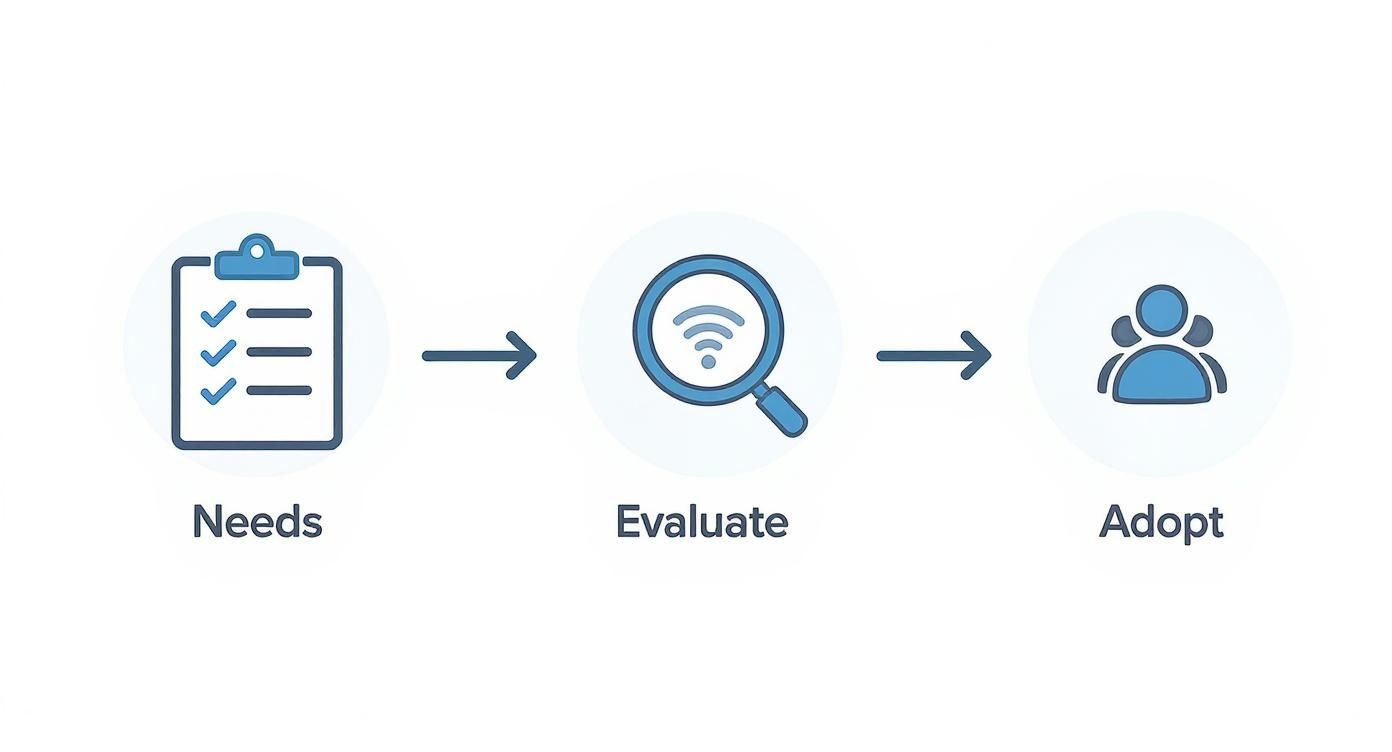Choosing the right CRM is a journey with three distinct phases: first, you must gain absolute clarity on your business needs. Next, it's time to evaluate the technology and the vendors offering it. Finally—and this is the part many overlook—you have to plan for a smooth implementation and secure team buy-in. Mastering these three stages is the difference between purchasing a glorified contact list and investing in a platform that genuinely fuels growth.
Why Choosing a CRM Is a Strategic Business Decision
In today's competitive landscape, a Customer Relationship Management (CRM) system is no longer a luxury; it's the operational heart of your organization. The conversation has shifted from if a business needs one to which one will align with its long-term strategy and simplify the daily work of its teams.
Treating this decision as a simple IT purchase is a common and costly mistake. The right CRM is a strategic asset that directly impacts your sales team's efficiency, the reach of your marketing campaigns, and the quality of your customer service. It acts as the connective tissue that allows every customer-facing team to operate from a single source of truth, creating a seamless and consistent client experience.
A Roadmap for Strategic Selection
Selecting the optimal system requires a structured plan that balances exciting features with the practical realities of your daily business operations. This guide is that roadmap, designed to move you from a vague understanding of your needs to a confident, data-backed decision.
This process is not arbitrary; it follows a logical progression that begins with an inward focus.

As illustrated, a successful outcome depends on moving sequentially through these phases. Without a solid foundation built on defining your true requirements, the evaluation and adoption stages are likely to falter.
The Modern Imperative for CRM
The data confirms that this technology is now standard operating procedure. A staggering 91% of companies with 10 or more employees use CRM software. The market has also overwhelmingly favored a specific delivery model: 87% of businesses now opt for cloud-based solutions due to their flexibility and integration capabilities.
Choosing a CRM is less about finding the software with the most features and more about identifying the platform that best solves your team's specific challenges and removes friction from their daily workflows.
This is especially true for fostering inter-departmental collaboration. An effective CRM breaks down the barriers between teams. When data flows freely, it eliminates the productivity-killing silos, a concept we explore further in our guide on how sales and marketing collaboration boosts business growth.
Ultimately, your goal is to find a tool your people will actually use—one that simplifies their jobs and delivers measurable results for the entire company.
Your CRM Selection Journey at a Glance
To help you visualize the path ahead, here’s a high-level overview of the key phases we'll be walking through. This table breaks down the entire process into manageable stages, each with a clear goal and set of activities.
Consider this your strategic blueprint. Following these phases will keep your project on track and ensure you're making a decision based on business needs, not just a flashy demo.
Defining What Your Business Actually Needs
Before you even consider a vendor demo, the most critical work must happen internally. The journey to choosing the right CRM doesn't start with software; it begins with an honest assessment of your business goals and the daily frustrations your teams face. Skipping this step leaves you vulnerable to being dazzled by features you'll never use—a fast track to an expensive, underutilized investment.
The first step is to translate broad business objectives into concrete, measurable CRM requirements. "Improve customer retention" is a laudable goal, but it's not an actionable criterion for a software search. You must dig deeper to understand what that actually looks like in practice.
For instance, does improving retention require:
- Automated customer health scores to flag at-risk accounts before they churn?
- Proactive task reminders for account managers to engage at critical lifecycle moments?
- A unified view of support tickets so the sales team is aware of ongoing issues before contacting a client?
This is how you build a bridge between your company's high-level strategy and the specific functionality the software must deliver.
Talk to the People on the Front Lines
You cannot draft a meaningful requirements list from the boardroom. The most valuable insights are embedded in the day-to-day workflows of the people who will use this system—your sales reps, marketers, and customer service agents. Their experiences and pain points are your most valuable data.
Sit down with them and ask pointed questions that uncover friction in their current processes. Avoid simply asking, "What do you want in a CRM?" as this often yields a generic feature wishlist. Instead, ask them to describe their day.
- "Walk me through what happens when a new lead comes in. Where does the information go? What is your immediate next step?"
- "What is one repetitive, manual task you wish you could eliminate from your weekly workload?"
- "Can you recall a time a deal was lost because you couldn't find the right information when you needed it?"
These conversations are revelatory. A sales rep might admit to spending an hour daily logging call notes, which points to a need for a CRM with excellent mobile voice-to-text functionality. A support agent might complain about toggling between three applications to see a customer’s full purchase history, highlighting an essential need for robust e-commerce integration.
The goal isn't just to compile a list of features. It's to build a detailed picture of your current state and define what a better future looks like—a future supported by the right technology.
From Conversations to a Concrete Document
Once you've collected this feedback, it's time to organize it into a formal requirements document. This document becomes your north star, guiding every subsequent decision. It should be clearly structured, outlining exactly what the system needs to do for each team.
If you need a refresher on the fundamentals, our guide on what CRM systems are and how they work offers excellent foundational knowledge.
This document is your best defense against "scope creep" and ensures you’re evaluating vendors against your needs, not their marketing pitch. It’s the single most critical asset you'll create in your quest to find a CRM that delivers genuine business value.
Weaving a CRM Into Your Existing Workflow

A powerful CRM should adapt to your business, not force you to abandon proven processes. After defining your goals, the next critical step is to map out precisely how a new system will integrate into your daily operations.
This is about flow, not just features. A system that adds more clicks, tabs, and manual work is a system destined for failure. Your team won't use it, and it will become a very expensive digital paperweight.
Start by visualizing your entire customer journey, from the first touchpoint to the final invoice. Avoid thinking in neat departmental silos; focus on the messy, real-world handoffs. Where is data passed between teams? Where do processes consistently break down?
Tracing Your Customer’s Path
Let's walk through a typical B2B sales cycle. Mapping this process helps pinpoint exactly where a CRM must add value, not friction.
Lead Capture: A prospect completes a form on your website. Where does that lead go now? Into a spreadsheet? Does someone manually copy and paste it into an email tool? Your new CRM must automate this, instantly creating a contact and lead record without human intervention.
Qualification: A sales development representative follows up. They need to see the initial form submission and have a clear, dedicated space to log call notes. The handoff to a senior account executive must be seamless, with all crucial context attached.
Quoting: Your account executive is ready to build a proposal. Are they currently pulling product information from one system and pricing from another? A good CRM integrates with quoting tools to generate documents directly from the opportunity record, eliminating version control issues.
Closing & Onboarding: The deal is won. Now, finance needs to send an invoice, and customer success needs the complete sales history for a smooth onboarding experience. This handoff is often a major bottleneck. A CRM connected to your accounting and project management software can make it seamless.
By mapping this flow, you create a tangible checklist of operational requirements. You're no longer asking a generic question like, "Does it have contact management?" Instead, you're asking, "Can it automatically push a closed-won opportunity into our accounting software?" The difference is profound.
The Technical Fit: Integrations and Infrastructure
With your workflow map in hand, the technical evaluation becomes much more focused. Instead of drowning in acronyms, you can zero in on the connections that truly matter to your business. The goal is to create a single source of truth, dismantling the data silos that cause frustration and inefficiency.
A CRM’s ability to communicate with your existing tech stack is non-negotiable. If it can’t integrate effectively, your teams will be stuck toggling between applications and manually copying data—the very problem you’re trying to solve. This is why a fundamental understanding of what is CRM integration is critical to making the right choice.
Key integrations to scrutinize with vendors include:
- Email & Calendar: Does it offer a native, two-way sync with Outlook or Google Workspace? Your sales team operates from their inbox; the CRM must work seamlessly within it.
- Marketing Automation: Can it sync lead scores, campaign engagement, and contact lists with platforms like HubSpot or Marketo? This alignment is essential for intelligent lead nurturing.
- Accounting Software: Will it connect to QuickBooks, Xero, or your ERP to automate invoicing and revenue tracking? This eliminates tedious manual reconciliation.
- Customer Support Tools: Does it provide a unified view of support tickets from systems like Zendesk or Intercom? A sales rep must know if their contact has an open support ticket before they call.
A CRM without strong integrations is just an isolated database. Its real power comes from acting as the central hub for all customer data across your entire organization.
Beyond integrations, you must consider the technical foundation. Your IT team will thank you for addressing these questions early.
Deployment Models and Security
Finally, you need to decide how the CRM will be hosted and ensure it meets your security standards. While not the most exciting aspect, it's one of the most important.
- Cloud (SaaS): The most common model. The vendor manages all infrastructure, resulting in lower upfront costs and easier maintenance for you. The trade-off is less control over the underlying environment.
- On-Premise: You host the software on your own servers. This offers maximum control over data and security but requires a significant investment in IT resources for management and maintenance.
- Hybrid: A combination of both, often used by companies with specific data residency requirements or complex compliance needs.
Regardless of the model, security is paramount. Ask every vendor for their compliance certifications (such as SOC 2, GDPR, or HIPAA if applicable). Investigate their data encryption policies for data "at rest" (on their servers) and "in transit" (moving across the internet).
This technical due diligence ensures the platform you choose not only works for your users but also protects your most valuable asset: your customer data.
How to Objectively Compare CRM Vendors

You’ve completed the internal work and now possess a detailed requirements document. That’s a significant achievement. Now, the exciting part begins: turning your focus outward to the critical process of evaluating CRM vendors. This is where marketing pitches intensify and feature lists begin to blur.
To cut through the noise, you need a structured, data-driven framework. A simple pros-and-cons list is insufficient. You need a tool that forces you to compare each option against the specific needs you've already defined. This is where a CRM evaluation matrix becomes your most valuable asset.
Think of this matrix as your customized scorecard. It allows you to grade each vendor on the criteria that actually matter to your business, ensuring your decision is based on objective analysis—not just a slick demo or a persuasive salesperson.
Building Your Evaluation Matrix
The power of the matrix lies in its structure. You aren't just listing features; you're assigning weight to them based on their importance to your daily operations. This ensures that a "must-have" requirement carries far more influence in the final score than a "nice-to-have" feature.
Organize your matrix into logical categories. For a professional services or B2B company, these categories are an excellent starting point:
- Core Functionality: This covers the absolute non-negotiables, such as contact and pipeline management, task automation, and reporting capabilities.
- Ease of Use: How intuitive is the interface? How many clicks are required for common tasks? This is a massive factor in user adoption.
- Integration Capabilities: How well does it connect with your existing tech stack—email, calendar, accounting software, and more?
- Scalability & Security: Can the system grow with you? What are its security credentials and data protection policies?
For each specific feature within these categories, assign a weight—for example, from 1 (low importance) to 5 (critical). As you evaluate each vendor, you'll score them on how well they meet that requirement. The final weighted score provides a clear, objective comparison.
Here's a simple template to structure your own evaluation matrix. It offers a clear, side-by-side view that simplifies identifying which vendor truly aligns with your needs.
Sample CRM Evaluation Matrix Criteria
By multiplying the weight by each vendor's score, you'll get a weighted score for every feature. Tallying these up will give you a final, data-backed number to guide your decision.
Uncovering the Total Cost of Ownership
One of the biggest mistakes businesses make is focusing solely on the monthly subscription fee. The sticker price is merely the tip of the iceberg. To get a true sense of the investment, you must calculate the Total Cost of Ownership (TCO).
The best CRM on paper is useless if hidden costs make it unsustainable. A thorough TCO analysis protects your budget and prevents surprise expenses down the road.
Your evaluation matrix needs a dedicated section for these often-overlooked costs:
- Implementation & Setup Fees: Does the vendor charge for initial setup, configuration, and team onboarding?
- Data Migration Costs: Moving existing customer data is complex. Will you need to pay for expert assistance?
- Training & Support: Is comprehensive training included, or is it an extra line item? What about ongoing premium support?
- Customization & Integration Fees: If you require custom fields or specific integrations, will that necessitate paid developer work?
A vendor that appears cheaper upfront can quickly become the most expensive option once these additional costs are factored in. Don't hesitate to press vendors for a complete picture of all potential expenses.
Prioritizing Mobile and Future-Proof Features
In today's fast-paced environment, your team needs access to customer data anytime, anywhere. This makes mobile capability a critical evaluation point. Recent studies show that 70% of businesses use mobile CRM systems to enhance their sales strategies, and those leveraging mobile platforms are 150% more likely to exceed their sales goals. When evaluating, ensure the platform offers a robust mobile experience with features like offline access and real-time data sync.
By combining weighted feature scoring with a clear-eyed view of the total cost, your evaluation matrix transforms a confusing decision into a logical, step-by-step process. This data-driven approach empowers you to look past the marketing hype and choose a true partner for growth. For a closer look at some of the platforms you might be evaluating, check out our guide on the top CRM software tools available today.
Demos That Reveal the Real Story, Not Just the Sales Pitch
This is where the rubber meets the road. After all the research, spreadsheets, and internal meetings, the vendor demo is your first real look under the hood. However, a standard, polished demo is pure sales theater, designed to gloss over clunky parts and spotlight flashy features you’ll likely never use.
Allowing the vendor to run their standard presentation is a significant mistake. To determine if a CRM can truly solve your problems, you must take control. Don't settle for a generic tour. Insist on a session built around your business, your data, and your team's real-world challenges.
Setting the Stage for an Honest Demo
Before you even book the video call, provide your top two or three vendors with a script. It doesn't need to be complex—just a few key scenarios you need to see them execute live. This isn't about being difficult; it's about ensuring a valuable use of everyone's time, not just another sales pitch.
For example, don't just let them show you a generic lead entry form. Give them something specific, like:
- "We just returned from a trade show. Show us how you'd import a spreadsheet of 50 new leads, which includes our custom fields for 'Booth Location' and 'Product Interest.'"
- "Once imported, walk us through setting up an automation that assigns these leads to the correct regional representative and initiates our 'Post-Event Nurture' email sequence."
This approach forces them off-script, making them prove their system’s flexibility and automation capabilities in a context that is meaningful to your business.
Asking Questions That Cut Through the Fluff
During the demo, your team must come prepared with pointed, operational questions. You’re trying to understand the day-to-day reality for your staff, not just what the executive dashboards look like.
Here are a few questions that get past the marketing spin:
- For your sales reps: "Show me the exact clicks needed to log a call, create a follow-up task, and move a deal to the next stage. How many different screens are involved?"
- For your sales managers: "Let's build a report from scratch, right now. I want to see our pipeline velocity, broken down by lead source, for the last quarter. How long does that take?"
- For your marketing team: "A prospect just clicked through our latest email campaign. Show us how that engagement activity appears on their contact record for a salesperson to see."
These questions reveal the truth about the user experience. A system can look beautiful, but if it takes ten clicks to perform a three-click task, your team will resist it, and user adoption will plummet.
The Litmus Test: A Structured User Trial
A demo is one thing; a hands-on trial is where the real insights emerge. Once you're down to your final two contenders, it’s time for a small group of your actual users to work in the software for a week. This cannot be a free-for-all—it requires a plan.
- Assemble a diverse test group: Include a top-performing rep who is an expert in your current system, a skeptical veteran who resists change, a tech-savvy marketer, and a manager. You need all these perspectives.
- Give them a mission: Don't just turn them loose. Provide a checklist of 5-7 core tasks they need to complete—actions they perform every day.
- Hold a debriefing session: After the trial, gather everyone. What was easy? What was frustrating? Where did they get stuck? This raw feedback is invaluable.
A successful CRM implementation is less about the technology and more about your team's willingness to use it. A trial that uncovers a clunky or confusing interface is a major red flag, regardless of how impressive the feature list looks.
Negotiating a Partnership, Not Just a Price
You’ve put the finalists through their paces and have a clear winner. Now it's time to discuss terms. Remember, this conversation is about much more than the monthly fee. You’re choosing a long-term business partner, and the contract must reflect that.
Drill down on these key areas:
- Pricing Models: Get clarity on per-user costs, annual commitments, and—critically—price locks for when you add more users.
- Service-Level Agreements (SLAs): Get written guarantees on system uptime (aim for 99.9% or higher) and response times for critical support tickets.
- Onboarding and Training: What's included? What's extra? Understand exactly what level of implementation support and training is standard versus what is considered a paid professional service.
As you look to the future, AI is becoming a massive differentiator. Projections show that over 70% of CRM systems will soon incorporate AI for features like predictive lead scoring and automated communication. Even more tellingly, companies using generative AI in their CRM are 83% more likely to exceed their sales goals.
Ask vendors about their AI roadmap. What’s coming next quarter? Next year? You can discover more insights about these CRM usage statistics on Astersense.com. This isn't just about buying a tool for today; it's about ensuring your investment won’t be obsolete tomorrow.
Planning for Adoption and Measuring Success
Choosing a vendor might feel like crossing the finish line, but the race has just begun. The most advanced CRM on the market is useless if your team refuses to use it. A smart selection process dedicates as much thought to user adoption as it does to software evaluation.
Think of your implementation plan as the bridge between the tool you purchased and the results you expect. This isn't just another IT project; it's a fundamental shift in how your business operates. A flawed rollout will result in an expensive digital paperweight and a frustrated team.
From Data Migration to Daily Use
Your first major hurdle is data migration. Moving years of contacts, deals, and notes into a new system is often where projects go awry. You must work closely with your vendor to ensure no data is lost or corrupted. A phased rollout can de-risk this process: start with a small pilot team to identify bugs and build early momentum before a full-scale launch.
Once the data is in place, training becomes the top priority. A single webinar is insufficient. You need ongoing, role-specific sessions. Your account executives must master pipeline management, while your marketing manager needs to be an expert in lead source tracking.
The real goal of training isn't to teach people which buttons to click. It's to show them exactly how this new tool makes their specific job easier and helps them achieve their targets more efficiently.
Winning Hearts and Minds with Change Management
People are naturally resistant to change. Sticking to old habits is human nature, which is why a proactive change management plan is essential. Success hinges on communication, empowerment, and building buy-in from the ground up.
- Appoint CRM Champions: Identify tech-savvy and enthusiastic individuals on each team. Designate them as go-to experts who can support their colleagues. Their grassroots advocacy is far more effective than any top-down mandate.
- Consistently Reiterate the "Why": Remember the pain points you identified initially? Continuously frame the CRM as the direct solution to the daily frustrations your team expressed.
- Spotlight Early Wins: When a sales rep closes a major deal using a new feature, celebrate it publicly. When the marketing team generates high-quality leads through a new campaign, highlight the success. Positive outcomes are contagious.
Getting your entire team to embrace a new way of working is a significant undertaking. For more practical strategies, check out our guide on the top 15 tips to increase CRM user adoption.
Proving the ROI with the Right Metrics
Finally, you must connect everything back to the business goals established at the outset. To demonstrate a real return on this investment, you need to track the right Key Performance Indicators (KPIs). These numbers will tell the story, in black and white, of whether the CRM is delivering tangible value.
Forget vanity metrics. Focus on KPIs that directly impact the bottom line:
- Sales Cycle Length: Are deals closing faster than before?
- Lead Conversion Rate: Are more of your leads becoming paying customers?
- Customer Lifetime Value (CLV): Are you retaining customers longer and increasing their spending?
- Sales Activity Levels: Are your reps making more calls, sending more emails, and setting more meetings—all tracked automatically?
When you measure these kinds of outcomes, the CRM transitions from a line-item expense to a proven engine for growth. This data not only justifies the investment but also provides the insights needed to continuously refine your processes for even better results.
Common CRM Selection Questions

Even with a solid evaluation framework, you will likely encounter challenging questions. Having guided numerous businesses through this process, I've seen common hurdles arise. Let's address some of the most frequent ones to help you move forward with confidence.
How Long Does CRM Selection and Implementation Take?
While this depends on your company's size and complexity, there are reliable benchmarks. For a small to mid-sized business, a focused evaluation process typically takes 2-4 months. It's crucial not to rush this strategic phase.
Once a decision is made, a basic implementation can be completed in a few weeks. However, for a more complex deployment involving significant data migration and custom integrations, you should budget 3-6 months. Setting realistic timelines is key to a successful outcome.
The Biggest Mistake to Avoid When Choosing a CRM
Without question, the most significant pitfall is becoming captivated by a long list of features before defining your actual needs. Many companies are distracted by advanced tools they will never use, which leads to an overly complicated system that teams are reluctant to adopt.
Always begin with a crystal-clear understanding of your team's real-world workflows. The goal is to find software that solves your specific problems, not to purchase the one with the most features.
All-In-One vs. Specialized Systems?
This choice depends on your existing tech stack and specific business needs. An all-in-one suite like Salesforce or Dynamics 365 can simplify operations and reduce vendor management.
Conversely, a "best-of-breed" CRM that integrates seamlessly with your other essential tools often provides deeper, more specialized functionality. If you choose this path, the single most important factor is the strength and reliability of the CRM’s integration capabilities. A specialized system is ineffective if it cannot communicate with the rest of your software ecosystem.
Navigating how to choose a crm system is a complex but absolutely critical task for any growing business. At Twelverays, we specialize in implementing and integrating powerful CRM solutions like Salesforce and Dynamics 365 to create a single source of truth that drives your business forward. Let our expertise guide your digital transformation. Get in touch with us today.





